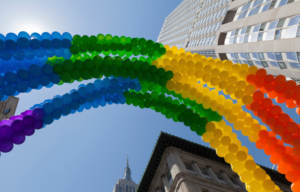Pride Celebrations
On a warm summer weekend in cities across America and around the world, gay communities gather to celebrate Pride. Depending on the locale and traditions, the festival typically involves a big parade, food and beverages, music, dancing and much more. Whether a full weekend of festivities or just a single day to come together for fun and appreciation of the strength of the community, Pride Festivals hold a special place in the hearts and minds of many lesbian, gay, bisexual and transgender (LGBT) people and their allies.
Tradition of Pride
When the Stonewall Inn was raided again, early Saturday morning June 27, 1969, by New York cops looking to harass and arrest some gays and drag queens like they had done on many previous weekends, the patrons fought back. What became known as the Stonewall Riots went on up and down Christopher Street in Greenwich Village for some time. This became the start of the modern LGBT rights movement.
A year later, planners in New York City, San Francisco, Los Angeles, Chicago, and other American cities commemorated the uprising that had occurred the previous June with a “Gay Liberation March”. Times were very different 45 years ago. Back then, there were little if any LGBT role models or public figures. Very few gays (as members of the LGBT community were typically called then) had the ability to live an open and honest existence in their lives. Although lesbians, bisexuals and transgender individuals participated, it took many years for the terminology in the community became more inclusive.
Marching through New York City with signs proclaiming gay pride wasn’t welcome to those preferring the status quo. Others were thrilled with the opportunity to come out publicly with who they really were.
Pride Spreads
The marches were a spectacular success. They spawned nearly a half-century of repeated annual events in cities across the country and around the globe. Over time, the title of the event has changed to the Gay Pride Parade and now just the Pride Festival. Although the events are celebratory, they’re also political. Many participants are actively involved in diverse efforts to raise awareness and inclusion in society. These activists have created remarkable social progress for LGBT rights in recent years. By presidential proclamation in 2012, June is LGBT Pride Month.
Worldwide Celebration
Pride Parades, and the festivals that often accompany them for a weekend or week-long series of events, occur regularly in cities as diverse and far-flung as:
- Nepal
- Moscow
- Tel Aviv
- Vancouver, Canada
The annual celebratory events have spread and become an annual fixture in June in cities across the globe. Some cities make Pride more of a Mardi Gras style festival; others retain more of its political and social activist core in celebrating LGBT community rights and progress toward inclusion.
Popular Pride
Even in some otherwise-conservative cities across America, the Pride Festival draws tens of thousands of celebrants. In Salt Lake City, Utah, celebrants gather in a downtown plaza for a weekend of fun, entertaining, and educational events, as well as plenty of food and beer. The Utah Pride Parade on Sunday morning has come to nearly rival the traditional Days of ’47 Parade. This celebrates the arrival of Mormon pioneers in the area nearly 165 years ago.
The largest Pride Celebration in the world is in Sao Paulo, Brazil. Crowds of 3 to 4 million celebrate gay culture and life. Gays and straights, queens and bears, allies and activists alike come together in the streets to echo the chant of the early Christopher Street Marchers in 1970: “Say it clear, say it loud: gay is good, gay is proud!”















